What is the Cost of an Overhead Crane System [2024]?
In order to help you understand how to budget for an overhead crane project, we’ve developed this article to address the different factors that can influence the cost of a new overhead crane system and then we'll provide price ranges for the most common types, sizes, and configurations of overhead cranes.
Editor’s note: This post has been updated to reflect current market pricing.
There’s more to buying overhead cranes than just the crane. Every day, we hear from customers nationwide about their research struggles. And we understand—an overhead crane is a complex machine with a complex pricing system. Not only are there so many types of overhead cranes, factors like your geographic location, how frequently it’ll be used, and the dimensions of your system can increase your investment by tens of thousands of dollars.
At Mazzella, we have over 70 years of experience quoting, designing, and installing overhead crane projects for customers in all types of industries. If you’re just starting your research, we understand that the process of buying and installing an overhead crane in your facility can be overwhelming.
First, we’ll discuss the factors that affect the cost of any overhead crane. Then, we’ll dive into the prices of common types, sizes, and configurations of overhead cranes.
What Affects the Price of an Overhead Crane?
To ensure you get the right type of overhead crane for your business, you should be ready to address the following information when you contact an overhead crane manufacturer to bid on your project:
- The job your crane needs to perform
- Business expansion needs that you’ll need to fulfill
- The capacity, or maximum rated load, that you need your crane to lift
- The span you need to cover under the crane, or horizontal distance, center-to-center, of the runway rails
- The capacity, or maximum rated load, that you need your crane to lift
- How often you will use your crane
- The estimated height of your crane, or required lift
- If you need a runway, the length of your bay that the crane will need to traverse
- Any special building or structural requirements for operation or installation
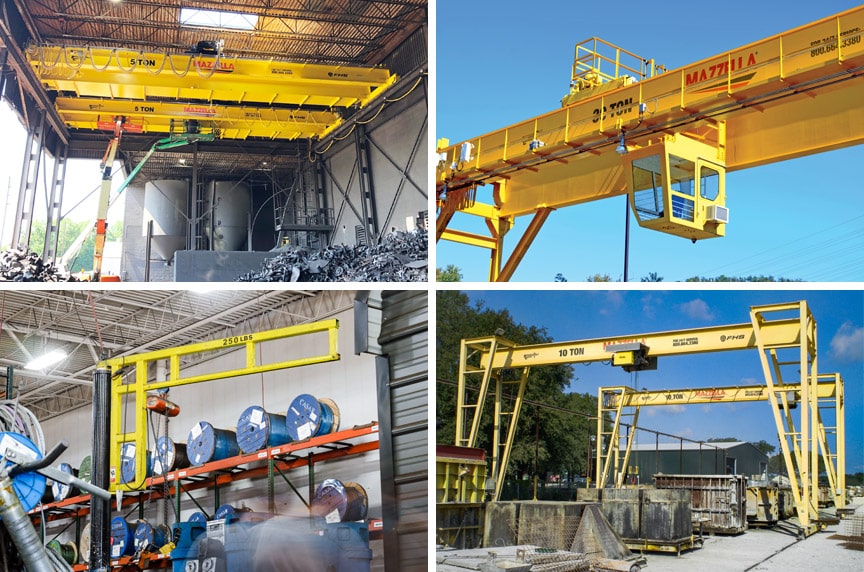
What Type of Overhead Crane do You need?
An overhead crane is a complex piece of equipment, and there are many different types of overhead cranes to choose from. The complexity of the overhead crane components required to operate the crane, the engineering required to design the crane, and the application (industry or materials being lifted) will determine what type of crane you’ll need.
For example, an 80 foot, 20-ton double girder bridge crane will cost significantly more than a 40 foot, 10-ton double girder bridge crane.
What is the Span of the Overhead Crane?
The span of an overhead crane, or distance between the centerline of the runway rails, is one of the biggest contributing factors to the cost of an overhead crane. The longer the crane’s span, the more material is required to build the crane girders. This added material increases the crane’s weight, which will also increase the cost of the runway, if required.
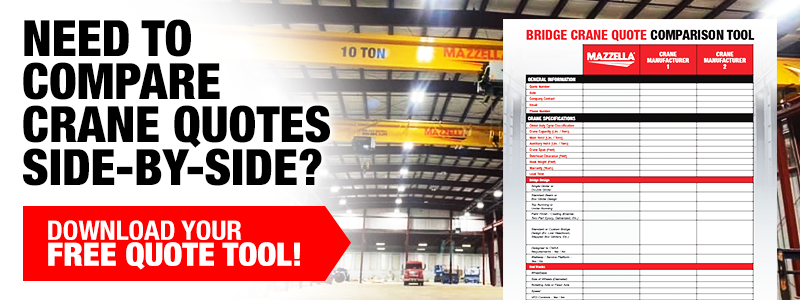
What is the Capacity or Maximum Rated Load?
An overhead crane’s capacity is the maximum load which may be applied to the crane in a particular working configuration, and under a particular condition of use.
When the manufacturer comes on-site to provide a consultation, they can calculate the capacity based on their understanding of:
- The size and weight of the material that you’ll be lifting
- Below-the-hook lifting devices that may need to be used
- Single hoist or double hoist configuration
- Any other considerations for future crane usage or capabilities
A crane that requires a large capacity, a large span, or severe service classification, may require a double girder design—meaning two beams make up the bridge and the hoist rides on top of the beams. These girders can be designed in a rigid welded steel box girder for added reinforcement. This type of setup will be the most expensive, as there are significant increases in labor and material charges to weld and fabricate the girders.
What is the Service Classification or Duty Cycle?
There are six different classifications of overhead cranes, specified by the Crane Manufacturers Association of America (CMAA). An overhead crane manufacturer will determine what type of crane classification they’ll need to build for your specific lifting application, using the following criteria:
- How frequently will the crane be used?
- How quickly will the crane need to transfer equipment or materials?
- How many lifts per hour will the crane need to perform?
- Will the crane be needed for regular or frequent service?
- How far does the crane need to move material in your facility?
- What is the average rated load of the materials that will be moving?
- How often will the crane be making lifts at full capacity?
- What environment will the crane operate in?
Class A and Class B cranes will be your least expensive option because they’ll be used mostly for maintenance or the initial installation of equipment. They’re used infrequently, and there are long periods of idle time between lifts.
Class C cranes will be a middle-of-the-road type crane. There may be some additional engineering built-in to the project for a specific need, but they typically utilize a basic hoist, trolley, and bridge design. They’re used moderately to handle loads at or around 50% capacity and are in service for about 5 to 10 lifts per hour.
Class D and Class E cranes, often referred to as process cranes, are built for a specific need and are more heavy-duty. They may consistently run over 50% of the rated capacity and make 15 or more lifts per hour. They have more engineering or customized solutions built into the design for the specific lifting application—which increases initial design and engineering costs for the project.
Class F cranes must be capable of handling loads approaching rated capacity continuously, under severe service conditions, throughout their lifetime. They’ll be extremely expensive due to additional costs related to design and engineering, sourcing of heavy-duty components, materials and labor, and installation.
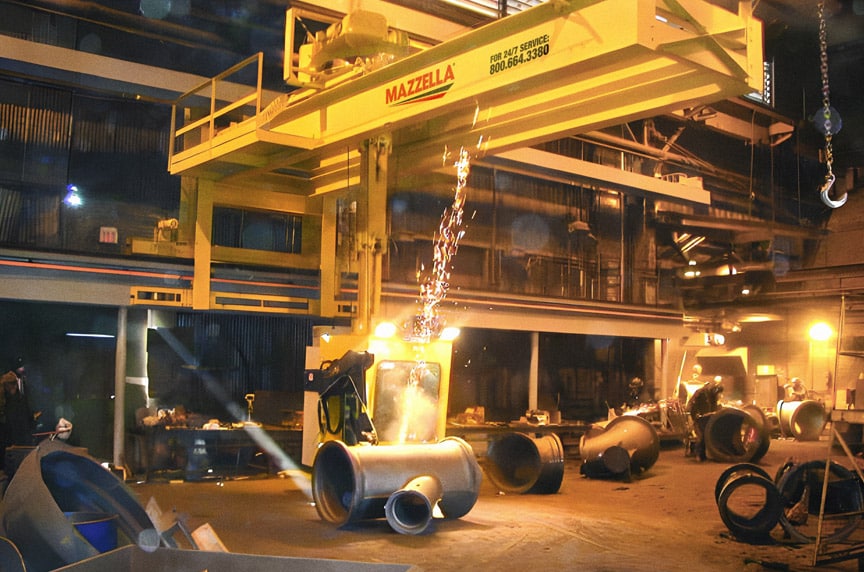
What is the Operating Environment?
A severe, obstructed, or dangerous operating environment where the crane will be installed and running, will affect the cost of an overhead crane in several ways.
Environmental factors such as high heat, the presence of chemicals or fumes, steam, dust, or excess moisture can require special metal coatings to protect and enhance the operating life of the crane. The individual components of the crane will also need to be sourced to ensure that they can hold up and withstand the operating environment.
We get consultation calls from all over the country, and how we install cranes in Wisconsin is different from how we’d install one in Louisiana. In geographic regions like the Southeastern United States, hot, humid summers mixed with rainy winters increase corrosion on cranes. To prevent this, additional coatings and weather sealings are needed. Also, AC or heating will increase the price.
Facilities like wastewater treatment plants, fertilizer plants, and oil and gas processing facilities require explosion-proof cranes, meaning the equipment can’t generate any spark. These cranes can utilize a specific pneumatic air-powered system or a specially designed electrical system to make them explosion-proof. However, these can be expensive to design and install.
Cranes used outdoors will need additional protective coatings to prevent corrosion and will require weatherproofing to seal out moisture, dust, or dirt. Also, stainless steel or galvanized components need to be sourced to ensure they handle exposure to the elements and don’t rust.
A dangerous operating environment will also require special equipment and protection (PPE) for the installers during an overhead crane installation. Any obstructions to the installation area can add to the cost if the installers don’t have clear access to the area to remove an existing structure or install a new one.
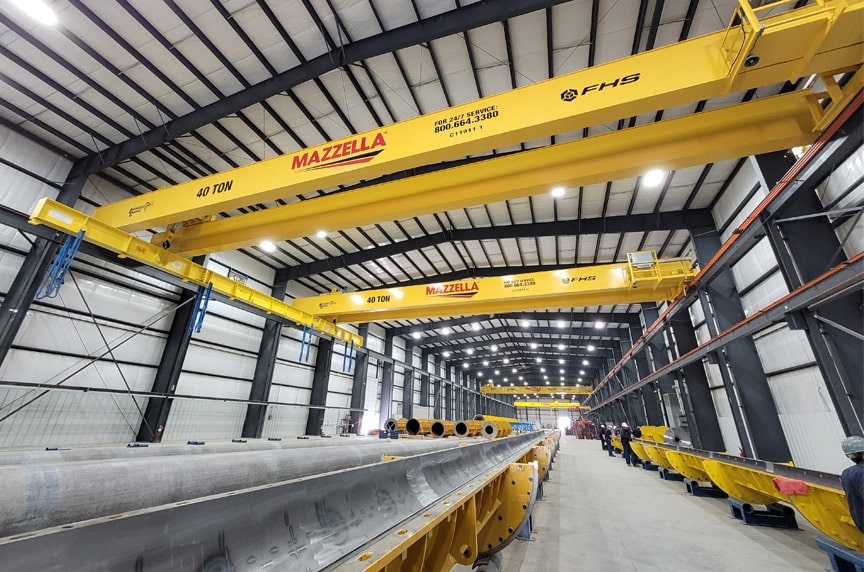
What is the Length of the Runway?
The runway length is the largest contributor to the runway cost itself. This length can also play into the cost of the crane. If you need to make multiple picks per hour and have a long runway, then you may need a faster bridge to move quickly up and down the runway. The additional speed may require the crane components to be sized with larger motors.
A faster crane that travels the length of the building may also require the operator to work from within an exposed or enclosed cab—which is more expensive than radio or pendant controls.
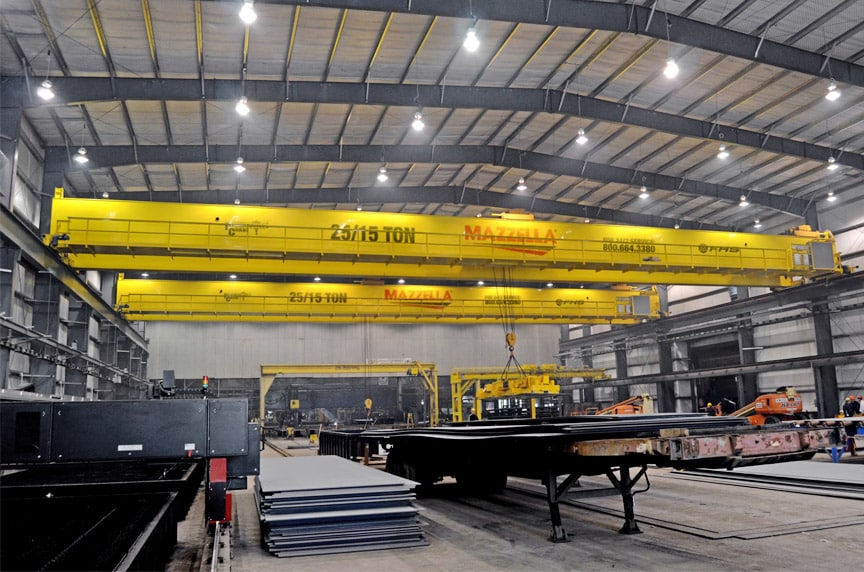
What are the Building or Structural Requirements for Operation or Installation?
When installing an overhead crane in a new construction facility, typically the runway beams will be installed during the construction process, and the crane manufacturer won’t need to include the runway structure in the quotation process.
Care must be taken with your construction contractor, as crane runway tolerances are much tighter than standard construction codes. Repairing a runway that’s out of tolerance can add significant cost to the installation. It is recommended to have the crane manufacturer also bid the runway portion of the project, as the installer will be more in-tune with CMAA standards for runways. The crane manufacturer should work with the building designer to make sure the building is designed to support the system properly.
If a crane is being retrofitted into an existing building, there will be added costs for the design, fabrication, delivery, and installation of the crane’s runway system.
Most crane manufacturers don’t offer in-house structural repair or certification services, so you’ll also have to consider any additional costs related to having concrete contractors or structural engineers provide a consultation of your facility. They’ll need to determine if the existing building structure and foundation can handle the additional loads generated by an overhead crane system.
What is the Quotation Process for an Overhead Crane?
The overhead crane quotation process can take anywhere from 3-30 business days, depending on the number of cranes being quoted, the complexity of the project, and the sourcing of crane components. Once they’ve completed this process, they’ll contact you to submit their official bid for the project.
Once you’ve gone through the consultation process, a group of estimators, engineers, draftsmen, and project managers all get together and begin putting together a comprehensive proposal.
Now that you understand all the different considerations and factors involved in determining the cost of an overhead crane, here’s what you can expect to pay, on average, for the most common sizes and configurations.
What is the Cost of an Overhead Crane?
NOTE: These prices DO NOT include installation costs, unless otherwise specified. Based on the points raised, some cranes could fall outside this price range.
Bridge Crane: $40,000–$100,000
Single Girder Crane: $40,000
- 5-ton capacity
- Span of 40 feet or less
- Base design trolley, hoist, and bridge
- 30% higher than it was three or four years ago
Double Girder Crane: $65,000–$100,000
- Recommended for heavy-duty applications
- There’s no limit to maximum span or capacity
- Cost includes installation
Semi-Gantry Crane: $130,000
- 5-ton capacity
- 40-foot span
- Includes hoist
- Typically, 1.5 to 2 times the cost of an equivalent bridge crane
- Hoist, trolley, railway included
Full Gantry Crane: $160,000–$170,000
- Additional charges due to structural system changes
Monorail Crane: $15,000–$25,000
- 2-ton capacity
- 20-foot span
- Includes hoist
- Cost is most dependent on length of the track and support structure. Will it be floor mounted or hung from ceiling?
Workstation Crane: Anywhere from $2,000–$80,000
- Capacities from 150 lbs. to 2-tons
- Coverage with up to 34-foot bridge span and unlimited runway length
- Up to 17 feet high clearance for free-standing design
- Free-standing or ceiling-mounted can affect price
- Wide price range is very dependent on span and length of runways
- 1-ton capacity with a 20-25 foot system will cost about $30,000
- 2-ton capacity will be about $40,000
- A freestanding structure would increase the price by about 30%
Jib Crane: Anywhere from $500–$25,000
- Capacities from 150 lbs. to 5-tons
- 4-foot to 30-foot spans
- Height under boom from 8 feet to 30 feet
- There are many different types of jib cranes, including:
- Free-standing
- Workstation (typically lighter capacity)
- Structural (can be designed up to 10-ton capacity)
- Mast-Type / Floor-to-Ceiling
- Tool jibs (typically lighter capacity)
- Structural (can be designed up to 10-ton capacity)
- Installation can add another $15,000–$25,000
- You may need to pour a foundation footer if your concrete isn’t strong enough, increasing the price.
Important questions to ask:
- Do you need a motorized crane, or will it be manually powered?
- What is the degree of rotation required?
Remember, these aren’t necessarily base-level prices, but instead are prices or ranges that we’ve seen for the most common configurations of each type of crane. The type of crane, the span, the capacity, the duty cycle, operating environment, and any additional building or structural considerations can all add to or lessen the cost of an overhead crane.
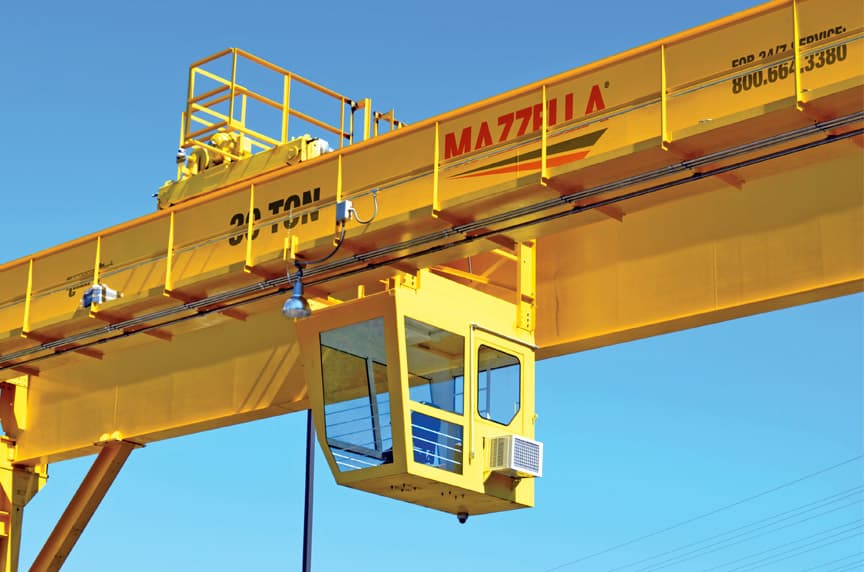
Wrapping it Up
There are so many factors affecting the price for an overhead crane system. The two most important aspects are span and capacity. These will determine how much labor and material will be required for the project and will also dictate the complexity and design of the hoist, trolley, bridge, controls, and power system—all major players in how much a crane will cost you.
At Mazzella, we have over 70 years of experience designing and building world-class overhead crane systems, ranging from light-duty economical cranes to large-capacity, high-duty cycle cranes.
Our expert team of Engineers, Estimators, Crane Specialists, and Project Managers can help you design and specify a cost-effective crane system for your facility, production or budgetary needs. Since every business is unique, and no two cranes are alike, we offer free quotes and consultations for overhead and material lifting projects. Want to schedule a consultation with a Crane Specialist? Contact us today.
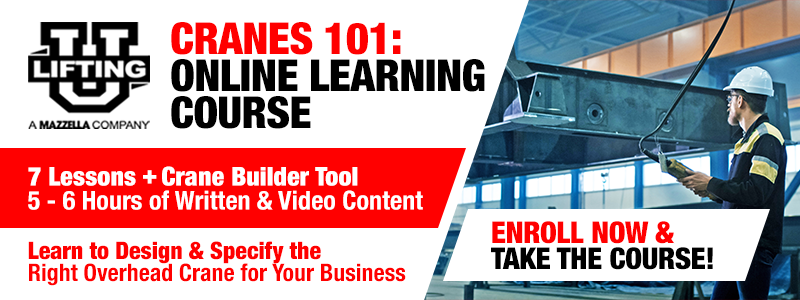
Copyright 2024. Mazzella Companies.
